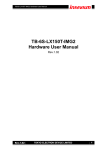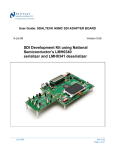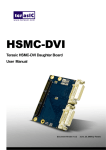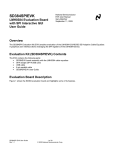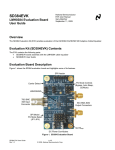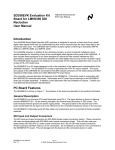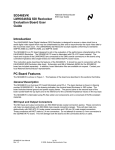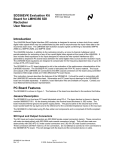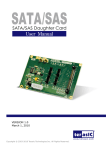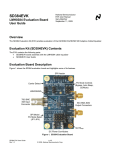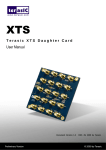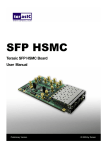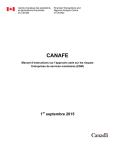Download SDI HSMC User Manual
Transcript
Terasic THDB-SUM SDI HSMC Terasic SDI HSMC Board User Manual Document Version 1.00 Document Version 1.00 AUG 21, Aug. 20 2009 by Terasic Introduction Page Index INTRODUCTION................................................................................................................................................................................. 1 1.1 1.1 FEATURES..................................................................................................................................................................... 1 1.2 1.2 ABOUT THE KIT ............................................................................................................................................................ 2 1.3 1.3 ASSEMBLE THE SDI HSMC BOARD ............................................................................................................................ 3 1.4 1.4 GETTING HELP ............................................................................................................................................................. 4 ARCHITECTURE ................................................................................................................................................................................ 5 2.1 2.1 LAYOUT AND COMPONETS............................................................................................................................................ 5 2.2 2.2 BLOCK DIAGRAM .......................................................................................................................................................... 7 BOARD COMPONENTS ................................................................................................................................................................... 8 3.1 3.1 THE SDI HSMC CONNECTOR ..................................................................................................................................... 8 3.2 3.2 AUDIO/VIDEO INPUT AND OUTPUT ............................................................................................................................. 16 3.3 3.3 CLOCK CIRCUITRY...................................................................................................................................................... 21 3.4 3.4 GENERAL USER INPUT/OUTPUT ................................................................................................................................ 24 3.5 3.5 POWER SUPPLY.......................................................................................................................................................... 25 DEMONSTRATION .......................................................................................................................................................................... 26 4.1 4.1 INTRODUCTION ........................................................................................................................................................... 26 4.2 4.2 SYSTEM REQUIREMENTS ........................................................................................................................................... 26 4.3 4.3 SETUP THE DEMONSTRATION .................................................................................................................................... 27 4.4 4.4 DEMO OPERATION ...................................................................................................................................................... 27 4.5 4.5 OVERVIEW .................................................................................................................................................................. 28 APPENDIX ......................................................................................................................................................................................... 30 5.1 5.1 REVISION HISTORY..................................................................................................................................................... 30 5.2 5.2 ALWAYS VISIT SDI HSMC W EBPAGE FOR NEW MAIN BOARD .................................................................................. 30 ii Introduction 1 Introduction The SDI HSMC Board is a transceiver serial digital interface HSMC board that provides a hardware platform for developing video broadcasting systems. It is intended to be used by customers to implement and design SDI and AES systems based on transceiver-based host boards with HSMC interface. Furthermore, the SDI HSMC board is designed for professional video equipment developers with SDI interface that allows FPGA design to access to industry standard video transport signals. 1.1 1.1 Features Figure 1.1 shows the photo of the SDI HSMC board. The important features are listed below: • • • • SDI Two SDI transmit (TX) channels with SDI cable tri-speed drivers Two SDI receive (RX) channels with SDI cable equalizers Two 75-Ω BNC SDI TX interfaces Two 75-Ω BNC SDI RX interfaces Adjustable 1.1 V to 1.8 V and Standard 3.3 V CMOS Input Signal Levels AES3 Two RS422 transceivers for AES3 TX and AES3 RX channels Two 75-Ω BNC AES3 RX interfaces Two 75-Ω BNC AES3 TX interfaces Power High frequency switching regulator for 12-V to 5-V power conversion Three linear regulators for 5-V to 3.3-V low noise power conversion FDTIM analysis for power distribution network (PDN) decoupling Clocks One SDI multi-frequency VCXO femto clock video PLL 98.304 MHz/90.3168 MHz/122.88 MHz/112.896 MHz voltage-controlled crystal oscillator (VCXO) based phase-locked loop (PLL) One LVPECL differential clock buffer with two differential outputs – HSMC and SMA • Four digital audio isolation transformers • One multi-format video sync separator • One HSMC connector for interface conversion, which is fully compatible with HSMC host boards 1 Introduction Figure 1.1. The SDI HSMC Board 1.2 1.2 About the KIT This section describes the package content • SDI HSMC Board x 1 • System CD-ROM x 1 The CD contains technical documents of the SDI HSMC, and one reference design along with the source code. Figure 1.2 SDI HSMC Package 2 Introduction 1.3 1.3 Assemble the SDI HSMC Board This section describes how to connect the SDI HSMC board to a main board, and using the Stratix IV GX FPGA Development Board as an example. The SDI HSMC board connects to the Stratix IV GX FPGA Development Board. Note. Do not attempt to connect/remove the SDI HSMC daughter board to/from the main board when the power is on, or else the hardware could be damaged. 3 Introduction 1.4 1.4 Getting Help Here are some places to get help if you encounter any problem: Email to [email protected] Taiwan & China: +886-3-550-8800 Korea : +82-2-512-7661 Japan: +81-428-77-7000 4 Architecture 2 Architecture This chapter covers the architecture of the SDI HSMC board including its PCB and block diagram. 2.1 2.1 Layout and Componets The picture of the SDI HSMC board is shown in Figure 2.1 and Figure 2.2. It depicts the layout of the board and indicates the location of the connectors and key components. Figure 2.1. The SDI HSMC PCB and component diagram 5 Architecture Figure 2.2. The SDI HSMC back side – HSMC connector view The following components are provided on the SDI HSMC board : • SDI Output Channel 2 (J1), SDI Input Channel 2 (J2), AES Output Channel 1 (J3), Equalizer Bypass Jumper (J5), Carrier Detect – Mute Jumper (J6), Equalizer Bypass Jumper (J7), SDI Output Channel 1 (J8), SDI Input Channel 1 (J9), AES Input Channel 1 (J10), SMA AES Clock Output (J12), AES Output Channel 2 (J14), AES Input Channel 2 (J15), SMA SDI Clock Input (J16), SMA SDI Clock Output (N) (J18) • SDI Cable Tri-speed Driver (U1), SDI Cable Tri-speed Driver (U2), AES VCXO PLL (U3), Mutli-format Video Sync Separator (U4), High Frequency Switching Regulator (U5), SDI Multi-frequency VCXO Femto Clock Video PLL (U6), LVPECL Differential Clock Buffer (U7), SDI Cable Equalizer (U8), RS422 Transceiver (U9), SDI Cable Equalizer (U10), Linear Regulator (U11), Linear Regulator (U12), Linear Regulator (U13), Single Gate Tri-state Buffer (U14), Single Gate Tri-state Buffer (U15), RS422 Transceiver (U16), HSMC Connector (J19) 6 Architecture 2.2 2.2 Block Diagram Figure 2.3 shows the block diagram of the SDI HSMC board Figure 2.3. The block diagram of the SDI HSMC board 7 Board Components 3 Board Components This section illustrates the detailed information of the components, connector interfaces, and the pin mapping tables of the SDI HSMC board. 3.1 3.1 The SDI HSMC Connector This section describes pin definition of the SDI HSMC interface onboard All the control and data signals of the SDI and AES are connected to the HSMC connector, so users can fully control the SDI HSMC board through the HSMC interface. HSMC connector. 8 Power is derived from 3.3V and 12V of the Board Components Figure 3.1. The pin-outs of Bank 1 on the HSMC connector 9 Board Components Figure 3.2. The pin-outs of Bank 2 of the HSMC connector. 10 Board Components . Figure 3.3. The pin-outs of Bank 3 of the HSMC connector 11 Board Components The table 3.1 below lists the HSMC signal direction and description. Table 3.1 Pin Name Direction Description 1 N.C. N/A Not Connect 2 N.C. N/A Not Connect 3 N.C. N/A Not Connect 4 N.C. N/A Not Connect 5 N.C. N/A Not Connect 6 N.C. N/A Not Connect 7 N.C. N/A Not Connect 8 N.C. N/A Not Connect 9 N.C. N/A Not Connect 10 N.C. N/A Not Connect 11 N.C. N/A Not Connect 12 N.C. N/A Not Connect 13 N.C. N/A Not Connect 14 N.C. N/A Not Connect 15 N.C. N/A Not Connect 16 N.C. N/A Not Connect 17 N.C. N/A Not Connect 18 N.C. N/A Not Connect 19 N.C. N/A Not Connect 20 N.C. N/A Not Connect 21 N.C. N/A Not Connect 22 N.C. N/A Not Connect 23 N.C. N/A Not Connect 24 N.C. N/A Not Connect 25 SDI_TX_P2 Input Differential transmitted data 26 SDI_EQOUT_P2 Output Differential received data 27 SDI_TX_N2 Input Differential transmitted data 28 SDI_EQOUT_N2 Output Differential received data 29 SDI_TX_P1 Input Differential transmitted data 30 SDI_EQOUT_P1 N/A Differential received data 31 SDI_TX_N1 Input Differential transmitted data 32 SDI_EQOUT_N1 Output Differential received data 33 N.C. N/A Not Connect Numbers 12 Board Components 34 N.C. N/A Not Connect 35 N.C. N/A Not Connect 36 N.C. N/A Not Connect 37 JTAG_TDO_TDI Inout JTAG data loop through 38 JTAG_TDO_TDI Inout JTAG data loop through 39 N.C. N/A Not Connect 40 N.C. N/A Not Connect 41 SDI_LED_TX_R1 Input Red LED signal transmit channel 1 42 N.C. N/A Not Connect 43 SDI_LED_TX_R2 Input Red LED signal transmit channel 2 44 N.C. N/A Not Connect 45 3V3 Power Power 3.3V 46 12V Power Power 12V 47 SDI_LED_TX_G1 Input Green LED signal transmit channel 1 48 N.C. N/A Not Connect 49 SDI_LED_TX_G2 Input Green LED signal transmit channel 2 50 N.C. N/A Not Connect 51 3V3 Power Power 3.3V 52 12V Power Power 12V 53 SDI_LED_RX_R2 Output Red LED signal receive channel 2 54 N.C. N/A Not Connect 55 SDI_LED_RX_G2 Output Green LED signal receive channel 2 56 N.C. N/A Not Connect 57 3V3 Power Power 3.3V 58 12V Power Power 12V 59 SDI_LED_RX_R1 Output Red LED signal receive channel 1 60 N.C. N/A Not Connect 61 SDI_LED_RX_G1 Output Green LED signal receive channel 1 62 N.C. N/A Not Connect 63 3V3 Power Power 3.3V 64 12V Power Power 12V 65 N.C. N/A Not Connect 66 N.C. N/A Not Connect 67 N.C. N/A Not Connect 68 N.C. N/A Not Connect 69 3V3 Power Power 3.3V 70 12V Power Power 12V 71 SDI_RATE_SEL1 Input Cable driver’s slew rate for desired bit rate 13 Board Components 72 N.C. N/A Not Connect 73 SDI_RATE_SEL2 Input Cable driver’s slew rate for desired bit rate 74 N.C. N/A Not Connect 75 3V3 Power Power 3.3V 76 12V Power Power 12V 77 EQ_BYPASS1 Input Equalizer bypass receive channel 1 78 N.C. N/A Not Connect 79 EQ_BYPASS2 Input Equalizer bypass receive channel 2 80 N.C. N/A Not Connect 81 3V3 Power Power 3.3V 82 12V Power Power 12V 83 AES_CLK_S0 Input AES frequency select 84 N.C. N/A Not Connect 85 AES_CLK_S1 Input AES frequency select 86 N.C. N/A Not Connect 87 3V3 Power Power 3.3V 88 12V Power Power 12V 89 AES_CLK_S2 Input AES frequency select 90 N.C. N/A Not Connect 91 AES_CLK_PDTSn Input AES clock power down and tri-state 92 N.C. N/A Not Connect 93 3V3 Power Power 3.3V 94 12V Power Power 12V 95 N.C. N/A Not Connect 96 AES_CLK Output AES clock reference 97 N.C. N/A Not Connect 98 N.C. N/A Not Connect 99 3V3 Power Power 3.3V 100 12V Power Power 12V 101 AES_OUT1 Input AES data output 1 102 AES_IN1 Input AES data input 1 103 AES_OUT2 Input AES data output 2 104 AES_IN2 Input AES data input 2 105 3V3 Power Power 3.3V 106 12V Power Power 12V 107 AES_VCXO_UP Input AES VCXO frequency control 108 N.C. N/A Not Connect 109 AES_VCXO_DN Input AES VCXO frequency control 14 Board Components 110 N.C. N/A Not Connect 111 3V3 Power Power 3.3V 112 12V Power Power 12V 113 SDI_CLK_SEL Input SDI clock input select 114 N.C. N/A Not Connect 115 SDI_XTAL_SEL Input SDI clock crystal select 116 N.C. N/A Not Connect 117 3V3 Power Power 3.3V 118 12V Power Power 12V 119 SDI_CLK_BP0 Input SDI clock control 120 N.C. N/A Not Connect 121 SDI_CLK_BP1 Input SDI clock control 122 N.C. N/A Not Connect 123 3V3 Power Power 3.3V 124 12V Power Power 12V 125 N.C. N/A Not Connect 126 N.C. N/A Not Connect 127 SDI_CLK_N0 Input SDI clock control 128 N.C. N/A Not Connect 129 3V3 Power Power 3.3V 130 12V Power Power 12V 131 SDI_CLK_N1 Input SDI clock control 132 N.C. N/A Not Connect 133 SDI_CLK_V0 Input SDI clock control 134 N.C. N/A Not Connect 135 3V3 Power Power 3.3V 136 12V Power Power 12V 137 SDI_CLK_V1 Input SDI clock control 138 N.C. N/A Not Connect 139 SDI_CLK_V2 Input SDI clock control 140 N.C. N/A Not Connect 141 3V3 Power Power 3.3V 142 12V Power Power 12V 143 SDI_CLK_V3 Input SDI clock control 144 ODDEVEN Output Video sync output of odd/even field 145 SDI_CLK_MLTF Input SDI clock control 146 VFORMAT Output Video sync output 147 3V3 Power Power 3.3V 15 Board Components 148 12V Power Power 12V 149 SDI_CLK_RST Input SDI clock control 150 VSYNC Output Vertical sync output 151 SDI_CLK_OE Input SDI clock output enable 152 HSYNC Output Horizontal sync output 153 3V3 Power Power 3.3V 154 12V Power Power 12V 155 SDI_HSMC_CLK Input SDI chip reference clock input 156 SDI_HSMC_CLK_P Output SDI clock hot reference clock 157 N.C. N/A Not Connect 158 SDI_HSMC_CLK_N N/A SDI clock hot reference clock 159 3V3 Power Power 3.3V 160 GND Power Power Ground 3.2 3.2 Audio/Video Input and Output This section describes the I/O channels of the SDI HSMC. SDI RX Channels The SDI RX channel consists of an SDI cable equalizer (LMH0344) with bypass, an input matching network, an input vertical mount with a 4-GHz BNC connector, a bypass control signal, DC blocking caps on the input and output, and a carrier detect LED. The RX channel receives 270 Mbps, 1.485 Gbps, and 2.970 Gbps SDI signals through a single-ended 75-Ω BNC connector. The singles traverse an impedance-matching network provided by the manufacturer. The input signal is terminated to ground with a 75-Ω external resistor and is input into the SDI cable equalizer via a 1- µF DC blocking capacitor. The opposite leg of the SDI cable equalizer’s differential input pin is terminated in the same way as the input signal and serves to correctly balance the input bias currents internal to the equalizer. The equalizer then equalizes the signal and outputs a 100-Ω differential signal to the SERDES receiver located on the host HSMC device. The differential output of the SDI cable equalizer passes through 1- µF DC blocking capacitors. 16 Board Components Figure 3.4 shows the SDI RX channel block diagram SDI TX Channels The SDI TX channel consists of a SDI cable tri-speed driver (LMH0302) with slew rate control, an output impedance matching network, an output vertical mount with a 4-GHz BNC connector, an SDI rate select control signal, DC blocking caps on the input and output, and a red/green LED. The SDI TX channel transmits at 270 Mbps, 1.485 Gbps and 2.970 Gbps rates using a 75-Ω coaxial cable. The SDI signals traverses an impedance matching network provided by the manufacturer and then goes through a DC blocking capacitor before being sent to the BNC connector. The output signal is back-terminated to 3.3 V externally with 75-Ω resistors. The output DC blocking capacitors consist of 4.7- µF 17 Board Components capacitors. The opposite leg of the SDI cable driver’s differential output pin is terminated in the same way as the output signal and serves to correctly balance the output currents internal to the device. The output of the TX pins of the HSMC host boards should not be installed with DC blocking capacitors. If DC blocking capacitors are installed, remove the capacitors and install 0-Ω resistors of the same foot print size (0402). The input of the SDI cable driver is differentially terminated with a 100-Ω resistor and has 4.7- µF DC blocking capacitors. Figure 3.5 shows the SDI TX Channel block diagram 18 Board Components AES3 RX Channels The AES3 RX channel delivers a 75-Ω load termination with a return loss of 25 dB or more. The signal is input through a 75-Ω BNC and terminated with a 75-Ω resistor to ground. The unbalanced signal is then balanced through an isolation transformer. The differential signal output from the transformer is biased and input to a RS422 transceiver. The output of the RS422 transceiver is a single-ended LVCMOS signal which is driven to the host board through the HSMC connector. Figure 3.6 shows the AES3 RX Channel block diagram 19 Board Components AES3 TX Channels The AES3 TX channel is designed to have a balanced signal driver to the isolation transformer. The output of the RS422 transceiver has an RX network to limit the output slew rate, thus limiting the bandwidth of AES3 output. The AE3 channel is designed to support 192-kHz to 24-kHz sample rates. The output is unbalanced with a source impedance of 75 Ω and a return loss of 25 dB or more. The peak-to-peak output voltage is 1.0V centered around the ground of the transmitter. Figure 3.7 shows the AES3 TX Channel block diagram 20 Board Components 3.3 3.3 Clock Circuitry This section describes the board’s clock inputs and outputs. SDI Clock The reference clocks can be generated from the host board, external video sources, and external SDI sources. The output of the clock generator should produce frequency of 148.5 MHz or 148.5 MHz/1.001 (148.35 MHz) from the SMA outputs or the HSMC connector. Figure 3.8 shows the SDI HSMC clocking diagram. Figure 3.8 SDI HSMC Clocking diagram The SDI multi-frequency VCXO femto clock video PLL (ICS810001-21) is utilized for the SDI reference clocks. The board inputs two crystals, 27 MHz and 26.973027 MHz to the clock generator which allow low-jitter operation for US and European SDI standard rates. crystal is locked by the internal VCXO. The HSMC signal SDI_XTAL_SEL determines which Clock inputs to the SDI PLL can come from either the HSMC host or through an SMA input where both inputs are end-terminated at 50 Ω to ground. SDI_CLK_SEL determines which input is active. 21 The HSMC signal Board Components The output of the clock generator is single-ended. A differential LVPECL clock buffer is used to convert the reference clock to differential signal and drive the signal to the host device to prevent common mode noise that might be present in the signaling path from the clock generator to the HSMC host device. Host Board Reference Clock You can select one of the several reference clock frequencies to input as a reference to the DI mult-frequency VCXO femto clock video PLL. For example, if the host board has a 100-MHz oscillator, you can divide the frequency by 6,400 to 15.625 kHz and drive that frequency to the clock generator to be multiplied to 148.5 MHz. We recommend locking the VCXO PLL to a stable oscillator which is located on the host board when the daughtercard is sourcing data or when the VCXO PLL is not locked onto a received signal or reference. This locking prevents wandering or frequency hunting. Loop Back Reference Clock From SDI Input When an RX channel is locked onto the input data stream, the recovered clock represents the actual bit rate of the stream. This recovered clock is often 74.25 MHz and can be buffered from the host board and driven out through the HSMC interface to the clock generator on the SDI HSMC. The clock output from the host is cleaned (jitter), multiplied to 148.5 MHz, and driven back to the host board to be used as the SERDES reference clock. Using this technique maintains the flow through timing. Studio Reference Timing If a studio clock source (a 27-MHz source) is available, the source can be connected to the EXT CLK IN SMA port on the daughtercard. Studio Reference Video Timing A video synchronizing separator is provided to synchronize the SDI video output streams to analog video. The horizontal and vertical syncs are driven to the host board and can be driven back to the video clock generator chip to produce a 148.5-MHz SERDES reference. AES3 Clock AES3 clocking uses clock device from IDT (ICS275-22) that comes with pre-programmed to produce 93.304 MHz, 90.3168 MHz (4x oversampling), 122.88 MHz, and 112.896 MHz (5x oversampling) from a 16.384-MHz crystal. Output CLK1 and CLK2 are connected to the HSMC and SMA connector respectively. CLK1 is connected to the MSHC connector and drives a signal to the host device. 22 Output Output CLK2 can be used Board Components for a reference, to trigger test equipment or to sync a signal to other devices in the AES3 system. The base part (ICS275) is a VCXO that can have various combinations of input, output, and feedback dividers to produce variations of the crystal frequency. The control voltage input of the device is controlled by a passive network of resistors and capacitors that are connected to tri-state buffers, one driven high and the other driven low when in the active state (non-tri-stated). The single gate devices are powered by 3.3 V to allow full swing of the control voltage (Vin, AES_CLK_V) because the ICS275 is also powered by 3.3 V. tri-state-enabled pins are controlled by the host device connected to the HSMC. The These pins should not be allowed to float. To use the ICS275 as a normally oscillator and not as a VCXO, drive signals AES_VCXO_UP and AES_VCXO_DN both to logic 1. Both output signals are enabled and the resulting voltage output after the resistor or capacitor network is a mid-voltage driven to the Vin of the ICS275 device. To use the ICS275 as a VCXO in a PLL application, connect the phase detector to the AES3 up and down control signals. Table 3.2 the audio rate and clock frequencies supported by the SDI HSMC Audio Sample Rate (kHz) Bit Rate Clock (MHz) Oversampling Rate VCXO Frequency 24.00 3.0720 32 98.3040 32.00 4.090 24 98.3040 44.10 5.6448 16 90.3168 48.00 6.1440 16 98.3040 88.20 11.2896 8 90.3168 96.00 12.2880 8 98.3040 176.4 22.5792 4 90.3168 192 24.5760 4 98.3040 24.00 3.0720 40 122.8800 32.00 4.0960 30 122.8800 44.10 5.6448 20 112.8960 48.00 6.1440 20 122.8800 88.20 11.2896 10 112.8960 96.00 12.2880 10 122.880 176.4 22.5792 5 112.8960 192 24.5760 5 122.8800 Table defines the frequency output with respect to the three 1-bit control signals, S [2:0]. and CLK4 are not used in the VCXO PLL. Outputs from CLK3 The frequencies programmed into the VCXCO PLL support 4x and 5x over-sampling of the most popular audio sample rates. 23 Board Components Table 3.3 VCXO PLL Frequency Output S2 S1 S0 CLK1 (MHz) CLK2 (MHz) CLK3 CLK4 0 0 0 98.304 98.304 OFF OFF 0 0 1 90.3168 90.3168 OFF OFF 0 1 0 122.88 122.88 OFF OFF 0 1 1 112.896 112.896 OFF OFF 1 0 0 98.304 122.88 OFF OFF 1 0 1 90.3168 112.896 OFF OFF 1 1 0 98.304 90.3168 OFF OFF 1 1 1 122.88 112.896 OFF OFF 3.4 3.4 General User Input/Output This section describes the user I/O interface to the board The SDI HSMC board has jumper switches CD_MUTE channels 1 and 2 and EQ_BYPASS channels 1 and 2. By default, the jumpers are installed on the CD_MUTE jumper switches (J4 and J6), while the EQ_BYPASS jumper switches (J5 and J7) are not installed. Jumpers J5 (EQ_BYPASS2) and J7 (EQ_BYPASS1) can be controlled from the host device. Table 3.4 lists the jumper descriptions and schematic signal names Board Schematic Reference Signal Name J4 CD_MUTE2 Description Standard Carrier detect jumper switch which connects to RX channel 2 (CD_MUTE2) on U8. J5 EQ_BYPASS2 I/O Signal short This jumper is normally installed. Equalizer bypass for RX channel 2. The equalizer can be CMOS by passed manually when EQ_BYPASS2 signal is tri-stated. This jumper is normally not installed and the switch is controlled by asserting the EQ_BYPASS2 signal. A high signal bypasses the SDI receiver equalizer. J6 CD_MUTE1 Carrier detect jumper switch which connects to RX channel 1 (CD_MUTE1) on U10. Signal short This jumper is normally installed. J7 EQ_BYPASS1 Equalizer bypass for RX channel 1. The equalizer can be bypassed manually when EQ_BYPASS1 signal is tri-stated this jumper is normally not installed and the switch is controlled by asserting the EQ_BYPASS1 signal. signal bypasses the SDI receiver equalizer. 24 A high CMOS Board Components 3.5 3.5 Power Supply This section describes the power supply on the SDI HSMC board The power distribution on the SDI HSMC board is shown in Figure 3.9 Figure 3.9 Power distribution on the SDI HSMC board 25 Demonstration 4 Demonstration This Chapter illustrates the reference design for the SDI HSMC board 4.1 4.1 Introduction This section describes the functionality of the demonstration briefly. The demonstration shows how to use the Stratix IV GX FPGA Development Board to test the functionality of the SDI video and AES audio transmit and receive pairs. The tests are PRBS data pattern loopback tests using the two AES digital audio ports and the two SDI digital video ports on the SDI HSMC. channel tests run at 24 Mbps and SDI tests run at 2.97 Gbps. 4.2 4.2 System Requirements The following items are required for the SDI HSMC demonstration. • HSMC SDI Board x 1 • Stratix IV GX FPGA Development Board x 1 • 75-Ω BNC to BNC Cables x 4 • Jumpers for CD_MUTE x 2 26 AES audio Demonstration 4.3 4.3 Setup the Demonstration Figure 4.3 shows how to setup hardware for the SDI HSMC demonstration. Note: The SDI HSMC board must be connected to HSMC Slot “A” of the Stratix IV GX FPGA Development Board for this demonstration. Figure 4.3 4.4 4.4 Demo Operation This section describes the procedures of running the demonstration FPGA Configuration Demonstration Setup, File Locations, and Instructions SDI HSMC Demo: • Project directory: S4PCIe_HSMCAESSDI_test • Bit Stream used: S4PCIe_HSMCAESSDI_test.sof 27 Demonstration • Connect the AES/SDI HSMC board to the Stratix IV GX FPGA Development Board to HSMC Slot “A” • Connect the 75-Ω BNC cables from: J1 (SDI OUT 2) to J2 (SDI IN 2) J8 (SDI OUT 1) to J9 (SDI IN 1) J14 (AES OUT 2) to J2 (AES IN 2) J3 (AES OUT 1) to J10 (AES IN 1) • Install Jumpers for J4 (CD_MUTE 2) and J6 (CD_MUTE 1) • Set the rotary switch (SW2) to the 1 position. • Power on the Stratix IV GX FPGA Development Board and download with SOF file (S4PCIe_HSMCAESSDI_test.sof) • Press reset button located on the host board to initiate the test 4.5 4.5 Overview This section describes the design concepts for the SDI HSMC demonstration. To monitor the results of each test, connect a BNC loopback cable between the corresponding, transmit and receive connectors. Tests run on all channels simultaneously, but only channels with loopback cables display accurate information. When the Stratix IV GX FPGA Development Board is powered on, the LEDs (D1, D3, D5, D6) alternate between the states of: OFF, RED, GREEN, ORANGE. Connection Test: The connection test verifies the connections made on the SDI and AES channels. By pressing pushbutton PB0 on the host board it will check if everything is connected correctly and data is being transmitted and received correctly. The USER LEDs 1, 2, 4, 5 on the host board correspond to links SDI port 1, SDI port2, AES port 1 and AES port2 respectively which will illuminate if the connection are connected correctly. If LEDs 1, 2, 4, 5 do not illuminate then there is connectivity issue with that link, otherwise if they all illuminate then the receivers are receiving the correct data. Error Insertion Test: The error insertion test inserts a bit error into the transmit data stream each time you press the following push button: By pressing pushbutton PB1 which forces an error links on SDI and AES1 that causes LEDs 2 and 5 to go out respectively. By pressing pushbutton PB2 which forces an error links on SD2 and AES2 that causes LEDs 1 and 4 to go out respectively. 28 Demonstration By pressing PB0, LEDS 1, 2, 4, 5 will turn back on. Self-debugging Test: Perform the following test to debug connectivity issues with the SDI transmitters to SDI receivers, and AES transmitters to AES receivers. By disconnecting BNC from SDI OUT 1 (J8), LED 2 will go out. By disconnecting BNC from SDI OUT 2 (J1), LED 1 will go out. By disconnecting BNC from AES OUT 1 (J3), LED 5 will go out. By disconnecting BNC from AES OUT 2 (J14), LED 4 will go out. You may cross connect the SDI transmitters to the SDI receivers, as well as the AES transmitters to the AES receivers. If during a cross connection a channel fails, then the failure is in the transmitter of that channel that was failing. 29 Appendix 5 Appendix 5.1 5.1 Revision History Date Change Log AUG 20 , 2009 Initial Version SEPT 23, 2009 SDI driver part number corrected in the SDI TX section 5.2 5.2 Always Visit SDI HSMC Webpage for New Main board We will be continuing providing interesting examples and labs on our SDI HSMC webpage. Please visit www.altera.com or hsmcsdi.terasic.com for more information. 30


































